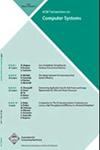SnowFlock:作为一级云原语的虚拟机克隆
IF 2
4区 计算机科学
Q2 COMPUTER SCIENCE, THEORY & METHODS
引用次数: 54
摘要
云计算的一个基本组成部分是虚拟化。虚拟机将用户的计算环境封装起来,并有效地将其与其他用户的计算环境隔离开来。然而,虚拟机是大型实体,目前还没有明确的api可以在短时间内为用户提供可编程的、细粒度的控制。我们提出了SnowFlock,这是一个云计算的范例和系统,它将VM克隆作为一流的云抽象引入其中。VM克隆利用了UNIX分支的易于理解和有效的语义。我们演示了VM克隆的多种使用模型:用户可以将原语合并到他们的代码中,可以通过脚本封装现有的工具链,可以将API封装在并行编程框架中,或者可以使用它来负载平衡和自扩展集群服务器。VM克隆需要高效才能可用。它必须有效地传输虚拟机状态,以避免云I/O瓶颈。我们将演示克隆的语义如何帮助我们实现其效率:状态并行地传播到多个VM克隆,并在运行时传输,从而实现大大减少I/O负载的优化。我们展示了详细的微基准测试结果,突出了优化的效率,而宏观基准测试数字则展示了SnowFlock不同使用模型的有效性。本文章由计算机程序翻译,如有差异,请以英文原文为准。
SnowFlock: Virtual Machine Cloning as a First-Class Cloud Primitive
A basic building block of cloud computing is virtualization. Virtual machines (VMs) encapsulate a user’s computing environment and efficiently isolate it from that of other users. VMs, however, are large entities, and no clear APIs exist yet to provide users with programatic, fine-grained control on short time scales.
We present SnowFlock, a paradigm and system for cloud computing that introduces VM cloning as a first-class cloud abstraction. VM cloning exploits the well-understood and effective semantics of UNIX fork. We demonstrate multiple usage models of VM cloning: users can incorporate the primitive in their code, can wrap around existing toolchains via scripting, can encapsulate the API within a parallel programming framework, or can use it to load-balance and self-scale clustered servers.
VM cloning needs to be efficient to be usable. It must efficiently transmit VM state in order to avoid cloud I/O bottlenecks. We demonstrate how the semantics of cloning aid us in realizing its efficiency: state is propagated in parallel to multiple VM clones, and is transmitted during runtime, allowing for optimizations that substantially reduce the I/O load. We show detailed microbenchmark results highlighting the efficiency of our optimizations, and macrobenchmark numbers demonstrating the effectiveness of the different usage models of SnowFlock.
求助全文
通过发布文献求助,成功后即可免费获取论文全文。
去求助
来源期刊

ACM Transactions on Computer Systems
工程技术-计算机:理论方法
CiteScore
4.00
自引率
0.00%
发文量
7
审稿时长
1 months
期刊介绍:
ACM Transactions on Computer Systems (TOCS) presents research and development results on the design, implementation, analysis, evaluation, and use of computer systems and systems software. The term "computer systems" is interpreted broadly and includes operating systems, systems architecture and hardware, distributed systems, optimizing compilers, and the interaction between systems and computer networks. Articles appearing in TOCS will tend either to present new techniques and concepts, or to report on experiences and experiments with actual systems. Insights useful to system designers, builders, and users will be emphasized.
TOCS publishes research and technical papers, both short and long. It includes technical correspondence to permit commentary on technical topics and on previously published papers.
 求助内容:
求助内容: 应助结果提醒方式:
应助结果提醒方式:


